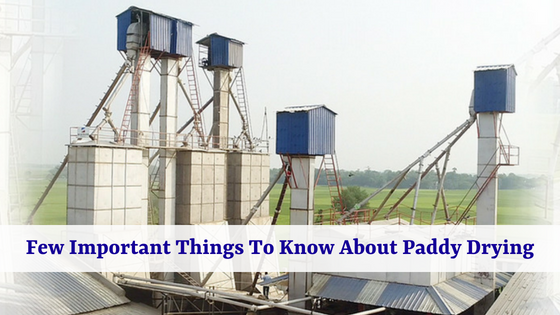A Few Important Things To Know About Paddy Drying
Drying of paddy entails a number of things. And here, we will have a look at only some of them.
Benefits Of Paddy Drying
- Maintains Quality Of The Grain
During harvesting time, the rice grains contain huge moisture level, as much as 20 to 25%. And this high moisture content of the rice often encourages development of harmful pests, insects and molds causing harm to the grains. It also lessens paddy’s germination rate. So don’t be late. Let the grains dry. Inadequate and ineffective drying doesn’t come handy. They can rather damage the quality of the grains.
- Saves Money, Time And Energy
Dried paddy are eligible for enhanced market value of the paddy. It ensures secured and steady income against minimum weather risks. It also ensures better income from being able to produce more amount of grain in any given time.

Needed Moisture Content For Proper Storage
- For storage period of 2 to 3 weeks – Required moisture content is 14 to 18%
- For storage period of 8 to 12 months – Required moisture content is 13% or even less
- For storage period of more than 12 months – Required moisture content is 9% or even less
Paddy Drying Process
Inappropriate drying often leads to development of fissure in rice. And fissure can have notable effect on the rice quality like reduction in head rice yield and the taste and value of cooked rice. So, to ensure good drying, it is highly required to dry paddy through several passes instead of a single pass. Rice mill machinery is used for quality paddy drying.
There are actually three different methods for drying paddy – field drying, sun drying, in-store drying and heated air drying.
|
Method |
Technology used |
Characteristics |
| 1. Field drying (not recommended) | Racks and piles | Rapid reduction of quality |
| 2. Sun drying | Drying mats or pavements |
|
| 3. In-store drying | Storage bin with proper aeration tools and pre-heater for poor weather and night drying |
|
| 4. Heated air drying | Re-circulating batch dryer |
|
| Continuous flow dryer |
|
|
| Fixed batch dryer |
|
These are some of the most important things about paddy drying. As it comes to installation of Paddy Dryer Plant, the economical feasibility, technical requirements and volume of paddy to be dries must be considered to ensure best drying.




